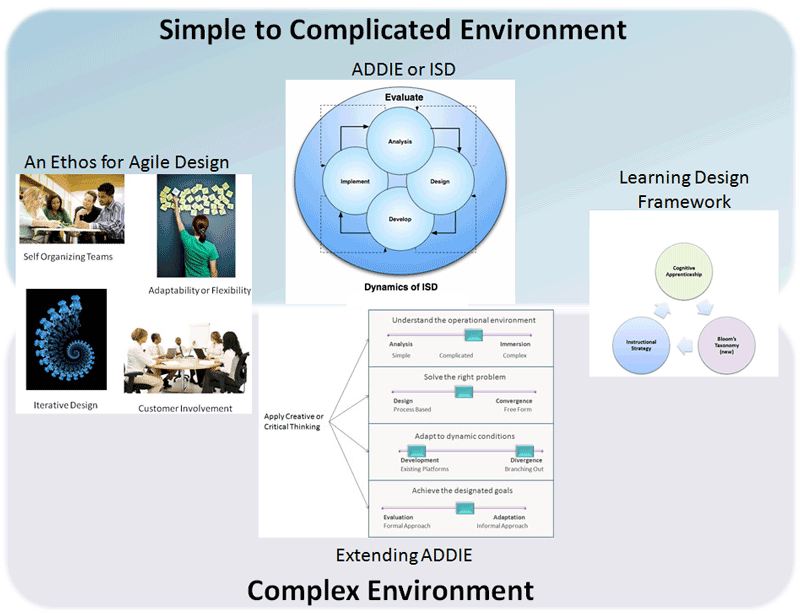Note: This site is moving to KnowledgeJump.com. Please reset your bookmark.
Blended Learning
One of the benefits of a blended learning platform is preventing the “the Lone-Learner syndrome”
While the concept of blended learning has been around since the beginning of Instructional Design, the term was not coined until the late nineties. The earliest reference that I can locate is an article titled, Blended Learning: the transformation of Higher Education Curriculum, from 2009.
Because elearning did not turn out to be the silver bullet that many of its proponents were harkening it to be, they needed another silver bullet to add to it, thus the concept of blended learning. In its early stages, blended learning meant the mix of classroom (brick) and e-learning (click), but it has now moved on to mean a mix of various learning methods and media.
However, blended learning is probably the closest thing we have to a silver bullet. In one study using a blended learning platform composed of classroom and elearning, it was shown to increase learning by an average of 11% for both procedural and declarative knowledge (Sitzmann, Ely, 2009).
There almost seems to be something almost magical about blending the interactive and social nature of classrooms, with the self-paced environment as each can deliver specific methodologies better than the other (Clark, 2001).
In addition, elearning can have an attrition or drop-out rate as high as 20% as it often treats the person as a “lone learner.” For example, in an informal learning episode a person will interact with an average of ten people (Tough, 1999). Adding blended learning with social media provides the social aspect that we need when it comes to learning so that it does not become a lone-learning environment.
Defining Blended Learning
There are brick and mortar options, such as coaching, classes, and mentoring. Then there are electronic options, ranging from e-learning classes, to on-line help systems, to templates, decision support tools, and knowledge bases. E-learning gurus Elliot Maisie and Brandon Hall recognize the many options and encourages combined systems, which they call 'brick and click,' or 'blended' learning" (Rossett, Sheldon, 2001, p.281).
Most definitions of blended learning follow the concept that it is a blended solution between elearning (on-line or click) and classroom learning (face-to-face or brick):
Blended Learning can combine the positive aspects of the two learning environments, classroom-based learning and e-Learning (Bonk, Graham, 2006).
However, some experts are now taking a broader view in that it goes beyond elearning and classrooms:
Blended learning is a mix of delivery methods that have been selected and fashioned to accommodate the various learning needs of a diverse audience in a variety of subjects. This method can include any combination of any of the above delivery methods (McSporran, King 2002).
Thus, Blended Learning is the use of two or more distinct methods of media. This may include combinations such as (Rossett, 2002):
- blending classroom instruction with on-line instruction
- blending on-line instruction with access to a coach or faculty member
- blending simulations with structured courses
- blending on-the-job training with brown bag informal sessions
- blending managerial coaching with e-learning activities
Why Blended Learning?
Learning requires some sort of experience to take place. And the experience may be quite different for each learner in that we have to consider differences in (Banathy, 1968):
- interest spans
- needs
- aptitudes
- achievements
- variations of time needed to master a specific learning task
- abilities to deal with abstractness or concreteness
- degree to which a learner needs to be guided
- abilities to deal with complexities
- abilities to manipulate objects (such as equipment or machines)
- the degree to which imaginations can be involved
- degrees to motivate creativity
- problem solving differences
Banathy further writes (p61) that a systems approach is multi-directional, in that it not only allows feedback, but it also has feed-ahead or feed-forward strategies for selecting learning experiences. Paul Saettler (1968, p271) notes:
A systems approach to instruction implies a scientific study of the kind of instruction required by each learner, the time when it is needed, and the appropriate design, organization, and operation of a system which can achieve behavioral goals. In its broadest sense, an instructional system is a set of interrelated components (not aids or adjuncts) in mutual interaction.
Thus, good instruction provides individual learning experiences within the learning environment by using a mixture of media, strategies, and methods. These learning experiences promote interactions that allow the learners to recall information so that it may be remembered and combine it with other experiences so that new knowledge bases may be formed. Again, going back to the roots of ISD, Meredith Crawford (1962) wrote,
. . . it may be observed that an ideal solution might provide a program adapted to the interests, aptitudes, and motivations of each learner. The experienced instructor, thoroughly familiar with the material and with the general and specific characteristics of the learner, has been recognized as the most efficient programmer, ever since the enunciation of the well-known statement (see note 1) about Mark Hopkins and the log.
Selecting Media
To help with your selection of the correct learning activities, select one of the options below:
1. This button will bring up a chart of various elearning activities, to learn more about the chart see, Designing eLearning
2. This button will bring up a chart of various learning activities, to learn more about the chart see, Selecting Learning Activities
3. This button will bring up a media selection flowchart (note that it is kind of old, but may prove useful)
Notes
1. The statement comes from U.S. President James Garfield in a speech he gave to Williams College alumni in 1871: "I am not willing that this discussion should close without mention of the value of a true teacher. Give me a log hut, with only a simple bench, Mark Hopkins (who was president of Williams College at the time) on one end and I on the other, and you may have all the buildings, apparatus and libraries without him."
Next Steps
-
Blended Learning
Related Resources
References
Banathy, B. (1968). Instructional Systems. Palo Alto, California: Fearon Publishers.
Bonk, C.J., Graham, C.R. (2006). The Handbook of Blended Learning. San Francisco: Pfeiffer.
Clark, R. (2001). Learning from Media: Arguments, Analysis, and Evidence. Greenwich, Connecticut: Information Age Publishing.
Crawford, M.P. (1962). Concepts of Training. Psychological Principles in Systems Development. Edited by Robert Gagne, (p.332).
McSporran, M., King, C. (2005). Blended Is Better: Choosing Educational Delivery Method. Retrieved from: http://hyperdisc.unitec.ac.nz/research/KingMcsporranEdmedia2005.pdf
Rossett, A. (2002). The ASTD eLearning Handbook. New York: McGraw-Hill.
Rossett, A., Sheldon, K. (2001). Beyond The Podium: Delivering Training and Performance to a Digital World. San Francisco: Jossey-Bass/Pfeiffer, p274.
Sitzmann, T., Ely, K. (2009). Web-Based Instruction: Design and Technical Issues which Influence Training Effectiveness. Retrieved from: https://www.moresteam.com/presentations/download/adl2009slides.pdf
Tough, A. (1999). Reflections on the study of adult learning. Paper presented at the 3rd New Approaches to Lifelong Learning (NALL) Conference, University of Toronto: Ontario Institute for Studies in Education, Toronto, Canada.
Vasileiou, I. (1999). Blended Learning: the transformation of Higher Education Curriculum. The Journal for Open and Distance Education and Educational Technology, Volume 5, Number 1.



